Table of contents
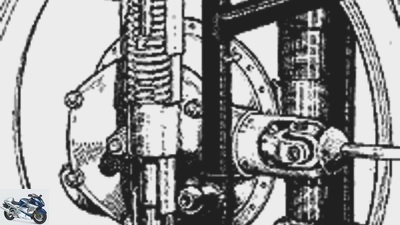
counselor
technology & future
Rear suspension
Rear suspension
Rear suspension
The first motorcycles had a rigid rear suspension. Since bumps in the road were introduced directly into the frame via the rear wheel, driving comfort was poor on uneven stretches.
02/25/2003
The first motorcycles had a rigid rear suspension. Since bumps in the road were introduced directly into the frame via the rear wheel, driving comfort was poor on uneven stretches.
The purpose of the spring connected between the wheel and the frame is to convert the kinetic energy that the wheel absorbs on uneven road surfaces into deformation energy. The so-called straight-line suspension initially prevailed on the rear wheel. The rear wheel with its axle is bolted directly to the spring struts. The shock absorber also takes on the task of guiding the wheel. The wheel is raised and lowered vertically. The spring travel that could be achieved in this way was limited. With chain drives, the distance between the sprocket and the chainring changed significantly. It was therefore only possible to select correspondingly low chain tensions in order not to overload the chain.
A cardan drive required two joints. The spring hub was a special design of the rear suspension. The two-part hub was connected by rubber elements so that the wheel bearing could move in relation to the wheel in the event of bumps in the road.
These designs were replaced by the rear swing arm. One strut is hinged to each of the two swing arms and the frame. With the one or two-armed swing arm, the wheel is guided in an arc around the swing arm bearing. Here, too, changes in length occur, but these can be reduced if the pivot point of the rocker moves as close as possible to the drive pinion.
In the case of the drive train swing arm, the motor-gear unit is screwed to the swing arm and thus takes part in its rotation without being sprung. This special construction can be found in scooters. The transmission ratio of the spring depends on the inclination and articulation of the suspension struts.
With increasing power, motocross motorcycles required ever greater suspension travel in order to ensure good ground contact even at high speeds on undulating slopes. In conventional designs with two struts, the spring travel is limited by the length of the struts and the installation space.
The first step towards realizing large suspension travel was the Yamaha cantilever swingarm. The rear wheel movement is transferred to a single spring strut via a triangular swing arm. The deflection causes a much shorter path on the strut than on the wheel axle. In the original arrangement with two struts and in the Yamaha cantilever design with one strut, the force required to compress the spring by a certain distance remains almost constant over the entire spring travel.
However, what is desired is a progressive spring rate with a significantly higher force increase per unit of travel at the end of the spring travel. The suspension can therefore respond sensitively to minor bumps. This also prevents the suspension from bottoming out in the event of major impacts and when fully loaded. A progressive spring rate can be achieved, for example, by specially winding the spring.
However, the Japanese high-volume manufacturers took a different path. At first they developed a spring system only for cross motorcycles, later also for road machines, in which a deflection with levers is connected between the shock absorber and the swing arm. By choosing the lever lengths, the transmission ratio can be varied as desired, and the arrangement of the levers influences the characteristic curve (measure of the displacement-force ratio) of the suspension.
The shock absorber is usually placed vertically in front of the rear wheel. The systems of the Japanese manufacturers are very similar in their structure. They only differ in the position and articulation of the levers on the rocker arm or on the frame. This means that every company has its own patent and a special company name.
With straight-line suspension, the strut is rigidly screwed to the frame at both ends. It takes over the wheel suspension and guidance.
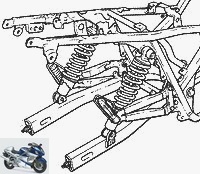
The conventional swing arm takes over the guidance of the wheel, the two struts take over the suspension.
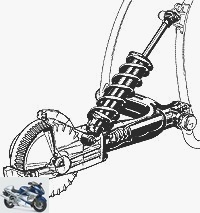
Despite the single shock absorber, the BMW Monolever construction works without progression.
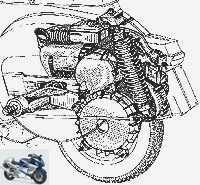
In the case of the drive train swing arm, the motor and gearbox are screwed to the swing arm in an unsprung manner.
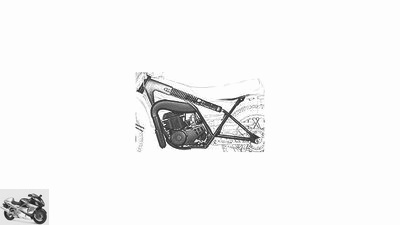
With the Yamaha cantilever swing arm, long spring travel can be achieved, but progression is hardly achievable.
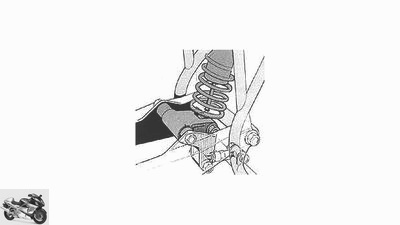
In modern central spring strut systems, the spring strut is linked to the frame or swing arm via levers.

The transmission ratio between wheel and spring movement changes in the course of the compression.

The Honda single-arm construction enables quick wheel changes in connection with progressive suspension.
Related articles
-
Screwdriver tip – care and inspection of the suspension struts
Photo: Ralf Petersen 14th pictures Ralf Petersen 1/14 1: Classic, beautiful and easy to adjust: stereo shock absorbers. Ralf Petersen 2/14 2: Efficient -…
-
Suspension special: Part 7 – rear
archive accesories landing gear & Spring elements Suspension special: Part 7 – rear Suspension special: rear Does the motorcycle drive strange lines?…
-
The technology of the chassis and suspension
Bilski counselor technology & future The technology of the chassis and suspension Technology: rear wheel The technology of the chassis and suspension…
-
Chassis special part 1: motorcycle suspension
fact accesories landing gear & Spring elements Chassis special part 1: motorcycle suspension Chassis special: suspension Everything about motorcycle…
-
Suspension special: Part 9 – Strut tuning
Jahn accesories landing gear & Spring elements Suspension special: Part 9 – Strut tuning Suspension special: strut tuning What good is the conversion of…
-
Suspension special: Part 3 – Strut damping
triumph accesories landing gear & Spring elements Suspension special: Part 3 – Strut damping Suspension special: shock absorber The right set-up for the…
-
Swing geometry and suspension behavior
Drawing: MOTORCYCLE motorcycles Swing geometry and suspension behavior Swing geometry and suspension behavior Chain reaction Full steam ahead, the chain…
-
motorcycles Suspension tuning Suspension tuning The right twist If you want to raid the curbs with momentum, you not only have to have yourself fully…
-
WP Suspension new road chassis
WP suspension accesories landing gear & Spring elements WP Suspension new road chassis WP Suspension Apex Pro and Xplor Pro New chassis for street bikes…
-
Suspension guide – correctly adjusting the damping, part 1
Photos: fact accesories landing gear & Spring elements Adjusting suspension / damping correctly, part 1 Guide: Adjusting the suspension / damping…